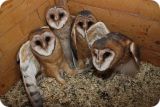séminaire du pôle évolution du vivant – vendredi 15 novembre 2013
 Negotiation for resources in sibling barn owls: a model of dynamics of animal communication
Negotiation for resources in sibling barn owls: a model of dynamics of animal communication
Amélie Dreiss, université de Lausanne
vendredi 15 novembre 2013 à 11 heures, amphithéâtre Monge
Animal conflict is usually seen as static, where each competitor has a definite underlying quality (i.e. condition, good genes) that determines its signal level. However, although many morphological signals are fixed during early development, some signals remain flexible through life (e.g. vocalisation, most behavioural traits). The level of signals of an individual can thus often fluctuate to avoid interferences, to adapt to both the presence of an audience or the resource holding potential and motivation of opponents. These fluctuations raise the question of how individuals decide at each moment their level of investment in signalling to claim a resource. Animals are indeed expected to constantly modulate their investment in a contest according to the payoff. Because of the inherent difficulty to study the temporal dynamics of communication between several individuals, how animals decide to enter or leave the contest and to what level invest in signalling has received mainly theoretical developments. Using the barn owl (Tyto alba) as a model species, I will present recent advances in the understanding of the role of cognition (individual recognition, memory) and social interactions in the dynamics of a communication process.
- titre:
- Negotiation for resources in sibling barn owls: a model of dynamics of animal communication
- intervenant:
- Amélie Dreiss
- date:
- vendredi 15 novembre 2013
- kc_data:
- a:8:{i:0;s:0:"";s:4:"mode";s:0:"";s:3:"css";s:0:"";s:9:"max_width";s:0:"";s:7:"classes";s:0:"";s:9:"thumbnail";s:0:"";s:9:"collapsed";s:0:"";s:9:"optimized";s:0:"";}
- kc_raw_content:
 Negotiation for resources in sibling barn owls: a model of dynamics of animal communication
Negotiation for resources in sibling barn owls: a model of dynamics of animal communicationAmélie Dreiss, université de Lausanne
vendredi 15 novembre 2013 à 11 heures, amphithéâtre Monge
Animal conflict is usually seen as static, where each competitor has a definite underlying quality (i.e. condition, good genes) that determines its signal level. However, although many morphological signals are fixed during early development, some signals remain flexible through life (e.g. vocalisation, most behavioural traits). The level of signals of an individual can thus often fluctuate to avoid interferences, to adapt to both the presence of an audience or the resource holding potential and motivation of opponents. These fluctuations raise the question of how individuals decide at each moment their level of investment in signalling to claim a resource. Animals are indeed expected to constantly modulate their investment in a contest according to the payoff. Because of the inherent difficulty to study the temporal dynamics of communication between several individuals, how animals decide to enter or leave the contest and to what level invest in signalling has received mainly theoretical developments. Using the barn owl (Tyto alba) as a model species, I will present recent advances in the understanding of the role of cognition (individual recognition, memory) and social interactions in the dynamics of a communication process.
- extrait:
- lien_externe:
